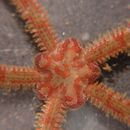Look Alikes
provided by Invertebrates of the Salish Sea
How to Distinguish from Similar Species: This is the only local species of brittle stars that has the supplementary plates.
- license
- cc-by-nc-sa
- copyright
- Rosario Beach Marine Laboratory
Habitat
provided by Invertebrates of the Salish Sea
Rocky intertidal or kelp holdfasts
- license
- cc-by-nc-sa
- copyright
- Rosario Beach Marine Laboratory
Distribution
provided by Invertebrates of the Salish Sea
Geographical Range: Worldwide, especially north temperate. On our coasts, Bering Sea to Santa Barbara, CA; most abundant in the north.
- license
- cc-by-nc-sa
- copyright
- Rosario Beach Marine Laboratory
Habitat
provided by Invertebrates of the Salish Sea
Depth Range: Lower intertidal to 2000 m
- license
- cc-by-nc-sa
- copyright
- Rosario Beach Marine Laboratory
Comprehensive Description
provided by Invertebrates of the Salish Sea
This brittle star is distinctive in this area because the plates on the aboral surface of the rays are separated from one another by smaller supplementary plates. The rays have five spines on the lateral plates, the middle of which is the largest. Color and pattern are extremely variable. The color usually includes red stripes or blotches, usually interspersed with brown but sometimes with green. Flora and Fairbanks state that it can sometimes be black and white or gray and brown. The oral surface is whitish.
- license
- cc-by-nc-sa
- copyright
- Rosario Beach Marine Laboratory
Comprehensive Description
provided by Invertebrates of the Salish Sea
Biology/Natural History: This is the main species common on rocky shores in our area. Others can be found in gravelly areas or in areas with boulders interspersed with sand. They feed by capturing food with their tube feet, by picking up detritus, or by mucus secreted by the rays. Predators include fish and harlequin ducks. Ovaries are red and testes are white. In our area they may spawn in Jan-March, July, October, or November. In the USSR, spawning seems to follow a lunar cycle. Metamorphosis from the larval stage does not occur until 83-216 days after fertilization.
- license
- cc-by-nc-sa
- copyright
- Rosario Beach Marine Laboratory

